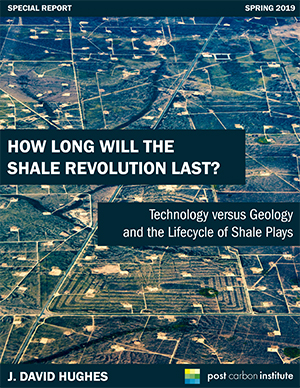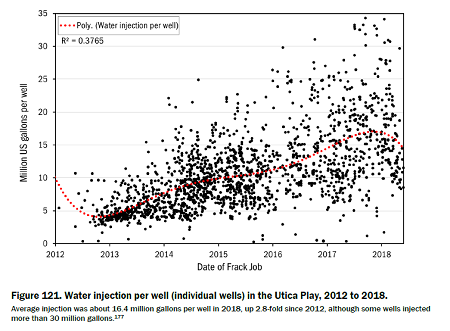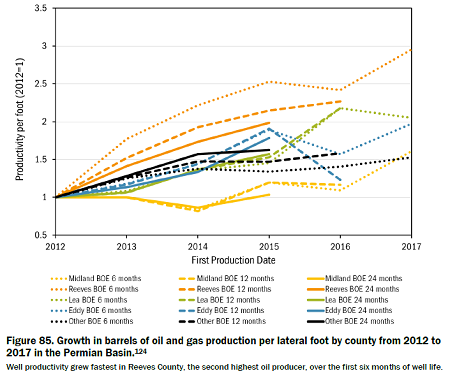
How Long Will the Shale Revolution Last?: Technology versus Geology and the Lifecycle of Shale Plays
May 2, 2019
How Long Will the Shale Revolution Last? provides a realistic assessment of future production in the the top ten tight oil and shale gas plays in the United States. Prepared by geoscientist J. David Hughes, the report utilizes the latest available data from both industry and government sources to quantify the impact of recent technological advances. It is the newest and most extensive of Hughes’s highly regarded independent analyses of U.S. shale production.
The ten plays reviewed in this report represent 93% of U.S. shale gas and tight oil production. Analysis highlights:
- Plays are evaluated in terms of type of energy produced, production and injection volumes per foot of horizontal lateral, and length of laterals.
- Play maturity is assessed through production trends, drilling rates, and remaining drilling locations.
- Geological variability is examined at the county level to assess the impacts on production of well-spacing and reservoir properties.
- Environmental impacts are assessed in terms of the rate of well drilling and the water and proppant volumes required for each well, along with collateral impacts.
The report is a protected PDF (47.2MB); 187 figures and tables, 281 pages.
Read the Executive Summary | Lee el Resumen Ejecutivo en español
Read the synopsis on OilPrice.com: “The Shale Boom Is About the Go Bust” (May 9, 2019)
Report Details
- Shale (Tight) Oil Plays Reviewed: Bakken, Eagle Ford, Permian, Niobrara
- Shale Gas Plays Reviewed: Marcellus, Utica, Haynesville, Woodford, Barnett, Fayetteville
- Length: 218 pages
- Figures and tables: 187
- Format and size: Protected PDF, 47.2MB
Inside the Report
The report looks at individual well data, such as in this analysis of water injection per well in the Utica Play.

The report looks at county level data, such as in this analysis of production in 6-, 12-, and 24-month-old wells in the Permian Basin.

The report summarizes findings at the play level and national level, such as here for the growth in horizontal lateral lengths and water injection per lateral foot since 2012.

U.S. oil and gas production has reached record highs as a result of applying technology and massive volumes of inputs to shale plays. Nonetheless, oil and gas from shale are finite resources. Therefore, the key question for industry, policymakers, investors, and residents in areas where drilling occurs is this: For how much longer can we expect technological improvements to overcome geological limitations?
About the Author
 David Hughes is an earth scientist who has studied the energy resources of Canada for four decades, including 32 years with the Geological Survey of Canada as a scientist and research manager. He developed the National Coal Inventory to determine the availability and environmental constraints associated with Cas coal resources. As Team Leader for Unconventional Gas on the Canadian Gas Potential Committee, he coordinated the publication of a comprehensive assessment of Canada’s unconventional natural gas potential.
David Hughes is an earth scientist who has studied the energy resources of Canada for four decades, including 32 years with the Geological Survey of Canada as a scientist and research manager. He developed the National Coal Inventory to determine the availability and environmental constraints associated with Cas coal resources. As Team Leader for Unconventional Gas on the Canadian Gas Potential Committee, he coordinated the publication of a comprehensive assessment of Canada’s unconventional natural gas potential.
Over the past decade, Hughes has researched, published and lectured widely on global energy and sustainability issues in North America and internationally. His work with Post Carbon Institute includes: a series of papers (2011) on the challenges of natural gas being a “bridge fuel” from coal to renewables; Drill, Baby, Drill (2013), which took a far-ranging look at the prospects for various unconventional fuels in the United States; Drilling California (2013), which critically examined the U.S. Energy Information Administration’s (EIA) estimates of technically recoverable tight oil in the Monterey Shale, which the EIA claimed constituted two-thirds of U.S. tight oil (the EIA subsequently wrote down its resource estimate for the Monterey by 96%); Drilling Deeper (2014), which challenged the U.S. Department of Energy’s expectation of long-term domestic oil and natural gas abundance with an in depth assessment of all drilling and production data from the major shale plays through mid-2014; and various updates to Drilling Deeper, most recently Shale Reality Check (2018).
Separately from Post Carbon, Hughes authored BC LNG: A Reality Check in 2014 and A Clear View of BC LNG in 2015, which examined the issues surrounding a proposed massive scale-up of shale gas production in British Columbia for LNG export, Can Canada increase oil and gas production, build pipelines and meet its climate commitments? in 2016, which examined the issues surrounding climate change and new export pipelines, and Canada’s Energy Outlook: Current realities and implications for a carbon-constrained future in 2018.
Hughes is president of Global Sustainability Research, a consultancy dedicated to research on energy and sustainability issues. He is also a board member of Physicians, Scientists & Engineers for Healthy Energy (PSE Healthy Energy) and is a Fellow of Post Carbon Institute. Hughes contributed to Carbon Shift, an anthology edited by Thomas Homer-Dixon on the twin issues of peak energy and climate change, and his work has been featured in Nature, Canadian Business, Bloomberg, and USA Today, as well as other popular press, radio, and television.
